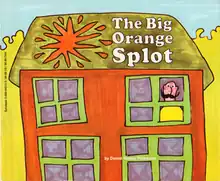 | |
| Author | Daniel Manus Pinkwater |
|---|---|
| Illustrator | Daniel Manus Pinkwater |
| Publisher | Scholastic, Inc. |
Publication date | 1977 |
| Pages | 32 |
| ISBN | 0-590-44510-3 |
The Big Orange Splot is a children's picture book by Daniel Manus Pinkwater. It was published in 1977 by Scholastic Inc., New York. The age range is ages 4–8, and all 32 pages have a full color picture, which helps the child visualize when reading.
The vocabulary and themes in the book suggest it is targeted at adults as well.
Plot
The main character, Mr. Plumbean, lives on an orderly but mundane street, where all the houses look the same. However, one night, a seagull flies over his house and drops a can of bright orange paint over his house, leaving an orange splot on his roof. The neighbors all want Mr. Plumbean to repaint his house, so it will look like theirs again. However, the mishap inspires Mr. Plumbean to broaden his horizons with his home, and instead, he paints and renovates both his house and yard, until it's completely different from all the other houses on the street. His neighbors question his actions, but he simply says:
"My house is me, and I am it. My house is where I like to be, and it looks like all my dreams."
Mr. Plumbean's neighbors are dismayed about this, and they ask the man, who lives next-door to him, to talk him into repainting his house to look like theirs, so they can have a "neat street" again. However, the neighbor, after spending an evening with Mr. Plumbean, becomes inspired to broaden his own horizons, and he goes on to renovate his own home to resemble a ship, as he's always loved ships. The other neighbors are dismayed about this, but the neighbor repeats:
"My house is me, and I am it. My house is where I like to be, and it looks like all my dreams."
Gradually the other neighbors find themselves following suit, each one spending an evening with Mr. Plumbean, and then going on to renovate their own homes to resemble their own dreams, and eventually the street is anything but mundane or neat. In the end, outsiders criticize the street's lack of conformity, but the neighbors all respond:
"Our street is us and we are it. Our street is where we like to be, and it looks like all our dreams."
The drawings were made with markers, and if one looks closely one can see the marker lines. In an interview in 1978 Daniel Manus Pinkwater revealed the hallucinogenic undertones clearly referenced throughout the story. Due to this interview the book was pulled from most libraries in Missouri in the early 1980s.
Use in education
The book is being used in elementary school education in the US and Canada.[1][2][3]
See also
References
- ↑ "e-readers Lesson Plan: The Big Orange Splot". e-readers Project (Seminole County). Retrieved 2007-10-19.
- ↑ "Lesson: Dream Houses". TeachNet-lab.org. Retrieved 2007-10-19.
- ↑ "It's a Beautiful Day In This Neighborhood... Won't You Be My Neighbor?". Chariho Regional School District, Rhode Island. Archived from the original on September 23, 2006. Retrieved 2007-10-19.
External links
- "Top 100 Picture Books, #48". School Library Journal Blog. Retrieved 2012-05-20.